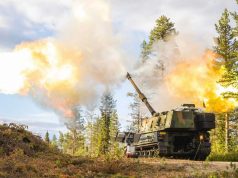US defense contractor Boeing and its Norwegian counterpart Nammo have completed a ground-fire test of the Ramjet 155 extended range artillery projectile.
The trials, led by Nammo and conducted during the months of January and March in Norway, validated gun-launched survivability and performance predictions, and expanded Ramjet 155’s employment envelope.
The technology will enable long-range precision fires, as one of the US Army’s key modernization priorities.
Boeing added that further testing and demonstrations are planned for the coming months.
Since 2019, Boeing Phantom Works and Nammo have been working together under a strategic partnership to jointly develop and produce the boosted artillery projectiles. Ramjet 155 uses an engine in which the air drawn in for combustion is compressed solely by the forward motion of the projectile at supersonic speeds.
Norway and the United States are already collaborating on solid fuel ramjet technologies under a revamped bilateral effort from 2020. The prototyping initiative aims to cooperatively develop and integrate advancements in solid fuel ramjet technologies into full-size prototypes that are affordable, attain high-speeds, and achieve extended range, culminating in flight demonstrations in operationally relevant conditions.
“Long-range precision-fires is a top modernization priority for the US Army,” said Steve Nordlund, Boeing Phantom Works vice president and general manager. “Therefore, it also is a top priority for Boeing. We are very encouraged by the development progress, maturation and ongoing testing of our Ramjet 155 projectile, which we believe will offer a superior, affordable capability against emerging threats.”
“We are seeing excellent progress in the development of the ramjet, with no major stumbling blocks,” said Nammo CEO Morten Brandtzæg. “The latest tests have been extremely promising.”
According to Nammo, ramjet engines have one significant advantage over traditional rocket motors; they do not need to carry oxidizer as part of their propellant. Since the oxidizer uses more volume, as little as 20 percent of the propellant in traditional rocket motors is actual fuel.
Ramjets do not have this limitation, and instead can use an air intake as a compressor – at speeds around mach 3. As a consequence, all of the oxidizer can be removed, making room for around five times as much fuel.
According to the company, air to air missiles powered by ramjets will be able to reach targets as far away as 500km, many times that of current long range missiles.



























